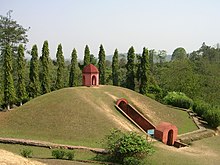| UNESCO World Heritage Site | |
|---|---|
 Royal maidam at Charaideo, 2009 | |
| Official name | Moidams – the Mound-Burial System of the Ahom Dynasty |
| Location | Assam |
| Criteria | Cultural: (iii) (iv) |
| Reference | 1711 |
| Inscription | 2024 (46th Session) |
Frang-Mai-Dam or Moidam for short (Ahom:𑜉𑜩𑜓𑜝𑜪;meaning:Burial of the dead) is a traditional tumulus of the Ahom religion.[1] The royal maidams of Charaideo are listed as UNESCO world heritage site.[2][3] Maidams are often compared with the Egyptian pyramids of the Pharaohs and the tombs of ancient Chinese royalty.[4][5] Today, the people of the four clans namely Mo-Hung, Mo-Cham, Chaodang and Mo-Plong follow the tomb tradition of Ahom religion. [1]
Structurally, a maidam consists of vaults with one or more chambers.[6] The vaults have a domical superstructure that is covered by a hemispherical earthen mound that rises high above the ground with an open pavilion at the peak called chow chali. An octagonal dwarf wall encloses the entire maidam.
Burial is the predominant funeral rite of the Tai people, to which the Ahom people originally belonged. This is opposed to the Hindu system of cremation. After the Ahom kings adopted Hinduism, they chose to bury the ashes after cremation.
The Ahom community in Assam consider the excavation as an affront to their tradition, because the maidams are associated with the Ahom ancestor worship and the festival of Me-Dam-Me-Phi.

- ^ a b Gohain, Dr. BK (2009). Tai-ahom Janagosthi Aru Tai Parampara Ed. 1st. p. 283.
- ^ World Heritage List
- ^ Kalita 2023, Times of India, Unesco ICOMOS Expert Arrives At Assam's Charaideo District, Vying For World Heritage Status
- ^ Moidams – the Mound-Burial system of the Ahom Dynasty - UNESCO
- ^ Desai, Raha (2004), page 450, The Dying Earth People's Action, Nature's Reaction,ACB Publications,ISBN:9788187500216, 8187500212
- ^ (ASI 2007)